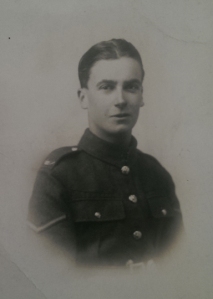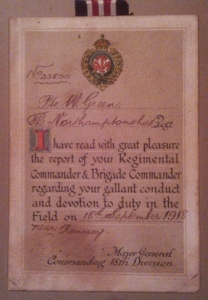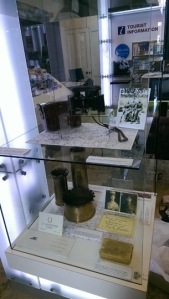Vikki Green – volunteer
Holding the pair of Emil Busch binoculars, it was hard to believe that they had seen trench warfare on the Hindenburg Line in 1918, and that they had passed through German and British hands. It was even harder to believe that they had belonged to my great-grandfather, William Green; a souvenir of the battles he had fought. When I first held those binoculars, it was instinct to take a look through the eyepiece. I wondered what William had seen when he did the same, and how different that sight must have been.
When I was asked to create a display for the Tourist Information Centre as a part of the Conflict and Community Project, I never imagined that I would also uncover my own past. I had taken on the challenge with the hope of being able to tell forgotten stories of wartime Northampton by showcasing some of the incredible items in the collection. The display will feature everything from shells to trench-art and Bovril to boots, as well as more personal items like a Christmas card belonging to Corporal A. Gilbert, and a pocket watch carried by Private J. H. Lack. As an Archaeology graduate, material culture has always fascinated me, and I wondered about the men that these items had belonged to, and what the story of their war had been. It was on this note that I began to do a little family research of my own.
I gradually began to uncover the story of Private William Green’s war, starting with his enlistment in 1915 at 20 years old, younger than I am now. He quickly qualified as a 1st Class Machine Gunner and Signaller, and was deployed in France. From his service records, I learned that William was quickly injured, and sent home to England after receiving a gunshot wound to the shoulder. However grievous his injury, it was this wound that led him to my great-grandmother; William was posted in Chatham, Kent, where he met Gladys Taylor.
He was soon back in France, however, now serving as a Lance Corporal. Though not long after, he was wounded once more, catching a bullet in his left leg. He convalesced in the 1st Southern General Hospital, Birmingham. Curiously, the University of Birmingham’s Aston Webb hall, the site of the military hospital, was the very same place in which I graduated in 2014. Our lives, though generations apart, had taken us both to the same place. William spent a lot of time convalescing in Woldingham, Surrey. His notes suggest he may have been suffering from shell shock.
After a long recovery, William returned once more to Chatham, in late 1917. Gladys must have been relieved to be reunited with her Tommy boyfriend and, consequently, he was stripped of his Lance stripes for being absent without leave on Valentine’s Day 1918.
It was not long before William was back in France with his battalion, to join the assault on the Hindenburg Line. It was in these late stages of the war that William found himself in Ronssoy Wood, one of the many battlefields of the Somme. For brave actions on the 18th of September 1918, he was awarded the Military Medal. Under heavy shellfire, William pulled his wounded comrades from the battlefield, until he himself was injured.
He was one of those fortunate enough to return home in 1919, though he never spoke of his war experiences. It was very clear to me that World War I had stripped William of his youth; he transformed from the cheeky young man who chose dates over duty, to a stern adult. As this was so often the case, the TIC display became even more important to me. It is my privilege to showcase the lives of the men who served in the Northamptonshire Regiment, and of my great-grandfather, who did not receive the commendation that he rightly deserved for his bravery.
The Conflict and Community project is encouraging us all to tell the stories of those who are no longer able. Finally, on the centenary of WWI, we are now able to talk about things the soldiers could not. Though it comes too late for my great-grandfather to appreciate, I hope that he knows just how proud we are of his actions on the front line, and that his story will not be forgotten.
The Conflict and Community display is situated in the Tourist Information Centre, Sessions House. I hope to continue to uncover such incredible artefacts, and tell their stories to the public. The display material changes every two months and, at present, represents life in the trenches. Please come along, and remember those of the Northamptonshire Regiment.
If, like me, you have a story to tell, or family research that relates to the Northamptonshire Regiment during the First World War, please get in touch. You can email hsanghera@northampton.gov.uk



